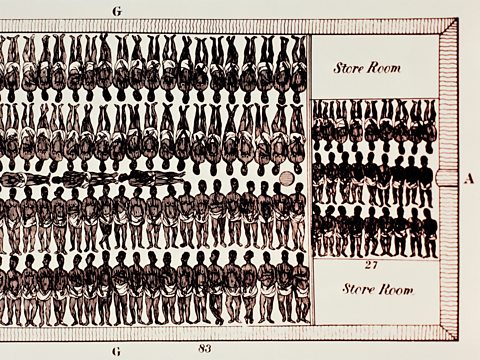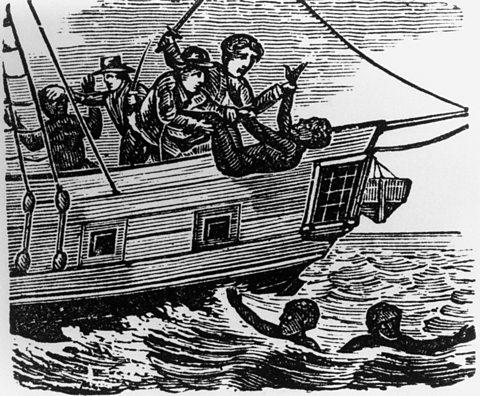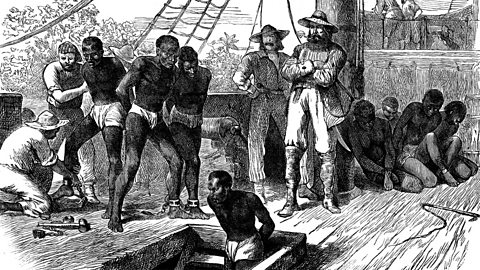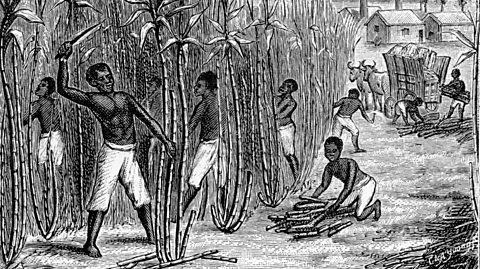What was the Middle Passage of the trade in enslaved Africans?
 Image source, ALAMY
Image source, ALAMYQuick version
The Middle Passage of the Triangular Trade was the journey that carried enslaved Africans across the Atlantic to the Caribbean and Americas…
There were two methods of loading enslaved Africans into the cargo hold of slave ships:
- tight pack - stowed as many people as possible onboard but had a higher death rate
- loose pack - stowed fewer people on board in an effort to stop disease spreading and reduce the death rate
Conditions aboard the slave ships were appalling:
- poor sanitation
- poor quality food
- cramped conditions
- enslaved people were exploited, abused and tortured
- disease and death were common.
In 1781 the crew of the Zong slave ship threw 131 enslaved Africans overboard to their deaths, after running low on water supplies. The incident caused outrage and was used to publicise the abolition movement.
The 1788 Slave Trade Act was introduced to try to improve conditions onboard slave ships by limiting the number of enslaved people on board.
Learn in more depth
Loading a slaver ship
 Image source, ALAMY
Image source, ALAMYOn the coast of Western Africa, Europeans traded manufactured good for captive African people.
They then set sail for Caribbean and the Americas.
This journey across the Atlantic was called the Middle Passage. Slave ships usually took between six and eleven weeks to complete the voyage.
Slave ships made large profits by carrying as many enslaved people as possible across the Atlantic to sell at auction. There were two methods of loading the ship:
- tight pack
- loose pack
 Image source, ALAMY
Image source, ALAMYWhat was tight packing?
The tight pack method involved packing as many enslaved people into the hold as possible. It was expected that some would die, but a large number would still survive the voyage, bringing a large profit.
A ship’s hold was cramped – only five feet high, with a shelf running round the edge to carry yet more enslaved people. People were loaded in so close together that one captain described them as being 'like books on a shelf'.
What was loose packing?
The loose pack method loaded fewer enslaved people into a ship's cargo hold, giving them more space to lie down.
These slightly better conditions were meant to reduce disease and death rates. This meant more enslaved Africans were likely to survive the voyage, which could lead to higher profits.
What were conditions like during the Middle Passage?
Regardless of whether they used a tight or loose pack method, conditions for captive Africans on board the ships were terrible.
Unsanitary conditions
- there were no toilet facilities - enslaved people had to go to the toilet where they were.
- rnslaved people were all chained together. If someone died, the body could remain in the hold for hours, still chained to other living people.
- the hold was dark, stuffy and stinking. The heat and the foul air were so bad that a candle would not burn due to the lack of oxygen
- food and water became contaminated from human waste - this caused dysenteryAn infection of the intestines that causes diarrhoea, stomach cramps and vomiting. (known as 'flux')
- sickness spread quickly
Poor food
- captive African people were often unable to digest the food carried by the European crew, making the sickness worse.
- fresh foods could not survive the hot, damp conditions, so food was limited to dry foods like oatmeal, or basic bread or biscuits
- salted meat or fish provided protein - however the high level of salt could cause dehydration
- lack of fresh fruit and vegetables led to scurvyDisease caused by severe lack of Vitamin C over a long period. Scurvy causes fatigue, gum disease and bleeding, and can be fatal., which could be fatal
- sick people were sometimes denied food and left to die
- some captive people refused to eat - when they did so they could be force fed
Mistreatment and humiliation
- the crew's treatment of enslaved people was often horrific
- women and children were kept separate from me - they could be subject to sexual exploitation
- some captive people were forced to dance on deck every day in an attempt to keep them fit
- any resistance was dealt with harshly by floggings from the crew.
- some enslaved people chose to take their own lives by jumping overboard rather than endure such brutal treatment
Sickness and disease
Sickness on board a slave ship would often spread to the crew as well, killing many.
The death rate among the enslaved people however, was horrific. It is estimated that 15–16 per cent of enslaved people died on the Middle Passage.
- Enslaved people were unable to go to the toilet.
- Sickness quickly spread.
- Enslaved people were all chained together. If someone died, the body could remain in the hold for hours, still chained to other living people.
- The hold was dark, stuffy and stinking. The heat and the foul air were so bad that a candle would not burn.
What resistance did captive Africans attempt on the Middle Passage?
The British crews of slave ships were greatly outnumbered by captive African people.
Crews feared captives rebelling. They used threats and violent punishment to maintain control.
Most captives were kept in chains but even so, many tried to resist their situation.
- some captives refused to eat - but they could be force fed as a result
- some refused to dance on deck or take part in enforced exercise - they were whipped as punishment
- some tried to take their own lives by jumping overboard - they were chained up to prevent this
On some ships, captive people attempted to get free, kill their captors or take control of the ship. Those caught were whipped or tortured. Ringleaders were sometimes killed.
For example, on 27 June 1770, Richard Norris, captain of the Unity wrote in his log that captives had…
…attempted to force up the gratings in the Night with a design to murder the whites or drown themselves, but were prevented by the watch. In the morning they confessed their intention and the women as well as the men were determined …to jump overboard but in case of being prevented by their irons were resolved as their last resource to burn the ship. Their obstinacy put me under the Necessity of shooting the Ring Leader.
Case study: The Zong, 1781-1783
 Image source, ALAMY
Image source, ALAMYThe Zong was a slave ship owned by Liverpool traders – one of whom, William Gregson, had been Lord Mayor of Liverpool.
Under the command of an inexperienced captain, and overcrowded with around 440 captive African people, the Zong set sail across the Atlantic in August 1781.
The ship missed its destination in the Caribbean and had to spend an extra three weeks at sea.
With water running out and fearing rebellion, the crew threw 132 captive African people overboard.
The Zong's owners attempted to claim compensation for the loss of their cargo of enslaved people. When the insurers refused, the case went to trial. After an initial trial and appeal, the courts ruled that the insurers did not have to pay.
No-one was ever charged with the deaths of the drowned Africans.
The case received little public attention at the time but came to symbolise the horrors of the Middle Passage and strengthened the abolition campaign.
 Image source, ALAMY
Image source, ALAMYSlave Trade Act, 1788 – Dolben's Act
 Image source, Shutterstock
Image source, ShutterstockIn 1788, British MP William Dolben put forward a bill to regulate conditions on board slave ships. He described horrors of enslaved people chained hand and foot, stowed like herrings in a barrel and stricken with putrid and fatal disorders.
The Slave Trade Act, 1788 was passed and controlled the number of captive people a ship was permitted to carry, according to its weight.
Dolben’s Act also ordered all slave ships to carry a doctor who had to keep records about the enslaved Africans on board.
These doctors received bonuses according to the number of Africans who survived the journey. Conditions however remained appalling.
 Image source, Shutterstock
Image source, ShutterstockTest what you have learned
Quiz
Recap what you have learned
The Middle Passage was the leg of the Triangular Trade that transported captive African people from the West Coast of Africa to the Caribbean and Americas.
There were two methods of transporting captives. Both aimed to maximise profit
| method | description | outcome |
|---|---|---|
| tight pack | as many captives as possible squeezed on board | many would die but traders hoped enough would survive to make a large profit |
| loose pack | fewer captives loaded with more space | a larger proportion would survive, so profits would be kept high |
Conditions on board
- Men were kept chained in the dark, cramped cargo hold
- Women and children were kept separate - sometimes on deck with little shelter
- Food was limited and lacked nutrition - captives became weak or ill
- Food and water became contaminated from human waste
- Lack of hygiene, cramped conditions and poor ventilation led to disease and illness
- Captives were subject to violence, torture and sexual exploitation
Resistance
Captives sometimes refused food, refused to exercise, jumped overboard, or planned to attack, overpower or kill the crew.
Those who attempted resistance were punished by whipping or other torture or killed.
It is estimated that 15 % of captive African people died during the Middle Passage.
In 1781, the crew of the slave ship Zong threw 132 captive Africans overboard to save drinking water and prevent rebellion. The ship's owners attempted to claim compensation for lost cargo. The case inspired abolitionists into action.
Changes to conditions
The 1788 Slave Trade Act (known as Dolben's Act) was passed to improve conditions onboard slave ships:
-limits on the number of captives* to be carried were imposed
- a surgeon/doctor was required for each ship
- surgeon's pay was linked to survival rates of captives
More on Trade in enslaved African people
Find out more by working through a topic
- count6 of 10
